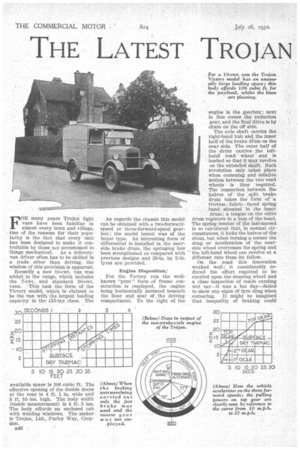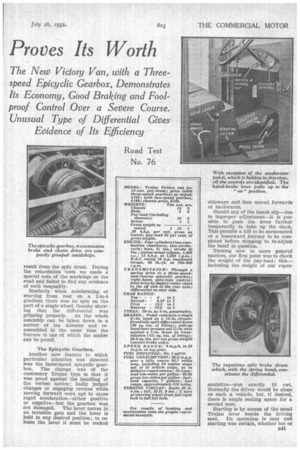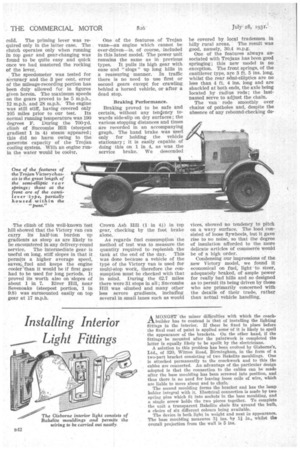THE LATEST TROJAN
Page 58

Page 59

Page 60

If you've noticed an error in this article please click here to report it so we can fix it.
Proves Its Worth
FOR many years Trojan light vans have been familiar in almost every town and village. One of the reasons for their popularity is the fact that every unit has been designed to make it controllable by those not accustomed to things mechanical. As a delivery
• van dfiver often has to be skilled in a trade other than driving, the wisdom of this provision is apparent.
Recently a new 10-cwt. van was added to the range, which includes the 7-cwt. and standard 10-cwt. vans. This took the form of the Victory model, which is claimed to be the van with the largest loading capacity in the 115-tax class. The
As regards the chassis this model can be obtained with a two-forwardspeed or three-forward-speed gearbox ; the model tested was of the latter type. An interesting form of differential is installed in the nearside brake drum, the springing has been strengthened as compared with previous designs and 29-in. by 5-in. tyres are provided.
Engine Disposition.'
For the Victory van the wellknown "punt" form of frame construction is employed, the engine being horizontally .mounted beneath the floor and seat of , the driving compartment. To the right of the engine Is the gearbox ; next in line comes the reduction gear, and the final drive is by chain on the off side.
The axle shaft carries the right-hand hub and the inner half of the brake drum on the near side. The outer half a the drum carries the lefthand road wheel and is bushed so that it may revOlve on the extended shaft. Such revolution only, takes place when cornering andrelative motion between the two road wheels is • thus required. The connection between the halves "of the .split brake drum takes the form of 'a friction -fabric faced spring band situated in the inner drum; a tongue on the miter drum registers in a loop of the band. The spring tension of the last-named is so calculated that, in normal circumstances, it locks the halves of the 4i-um, but when turning a corner the drag or acceleration of the nearside wheel overcomes the spring and the left-hand wheel can revolve at a different rate from its fellow.
On the road this innovation worked well; it considerably reduced the effort required to be exerted upon the steering wheel and a close inspection of roads exuding wet tar—it was a hot day—failed to show any signs of tyre drag when cornering. It might be imagined that inequality of braking could result from the split drum. During the retardation tests we made a special note of the markings on the road and failed to find any evidence of such inequality.
Similarly when accelerating or starting from rest on a 1-in-4 gradient there was no spin on the part of a single wheel, thereby showing that the differential was gripping properly. As the whole assembly can be taken down in a matter of ten minutes and reassembled in the same time the feature is one of which the maker can be proud.
The Epicyclic Gearbox.
Another new feature to which particular attention was directed was the three-speed epicydie gearbox. The change was of the customary Trojan type in that it was proof against the handling of the veriest novice ; badly judged changes or engaging reverse while moving forward were apt to cause rapid acceleration—either positive or negative—but the gearbox was not damaged. The lever moves in an invisible gate and the lever is held in any desired position; to release the lever it must be rocked sideways and then moved forwards or backwards.
Should any. of the bands slip—due to improper adjustment—it is possible to push the lever farther temporarily to take up the slack. This permits a hill to be surmounted or a homeward journey to be completed before stopping to re-adjust the band in question.
Turning now to more general matters, our first point was to check the weight of the pay-load; this— including the weight of our repre sentative—was exactly 10 cwt. Normally the driver would be alone on such a vehicle, but, if desired, there is ample seating space for a second man.
Starting is by means of the usual Trojan lever beside the driving seat. Its operation is easy and starting was certain, whether hot or cold. The priming lever was required only in the latter case. The clutch operates only when running in top gear and gear-changing was found to be quite easy and quick once we had mastered the rocking of the lever.
, The speedometer was tested for accuracy and the 3 per cent, error of the mileage-recording portion has been duly allowed for in figures given herein. The maximum speeds on the gears proved to be 5 m.p.h., 12 m.p.h. and 28 m.p.h. The engine was still stiff, having covered only 105 miles prior to our test. Its normal running temperature was 190 degrees F. During the 700-yd. climb of Succombs Hill (steepest gradient 1 in 4) steam appeared ; this did no harm owing to the generous capacity of the Trojan cooling system. With an engine runin the water would be cooler.
The climb of this well-known test hill showed that the Victory van can carry its half-ton burden up gradients as steep as are likely to be encountered in any delivery-round service. The intermediate gear is useful on long, stiff slopes in that it permits a higher average speed, savesp..,fuel and keeps the engine cooler 'than it would be if first gear had to be used for long periods. It proved its worth also on slopes of about 1 in 7. River Rill, near Sevenoaks (steepest portion, 1 in 9.8) was surmounted easily on top gear at 17 m.p.h. One of the features of Trojan vans—an engine which cannot be over-driven—is, of course, included in this latest model. The power unit remains the same as in previous types. It pulls its high gear with ease and " slogs " up long hills in a reassuring manner. In traffic there is no need to use first or second gears except for crawling behind a horsed vehicle, or after a dead stop.
Braking Performance.
Braking proved to be safe and certain, without any tendency towards side-slip on dry surfaces ; the various stopping distances and times are recorded in an accompanying graph. The hand brake was used only for holding the vehicle stationary ; it is easily capable of doing this on 1 in 4, as was the service brake. We descended Crown Ash Hill (1 in 41) in top gear, checking by the foot brake alone.
As regards fuel consumption the method of test was to measure the quantity required to replenish the tank at the end of the day. This was done because a vehicle of the type of the Victory van is used for multi-stop work, therefore the consumption must be checked with that in mind. During the 62.7 miles there were 31 stops in all ; Suecombs Hill was °limbed and many other less severe gradients, including several in small lanes such as would
be covered by local tradesmen in hilly rural areas. The result was good, namely, 30.4 m.p.g.
One of the features always associated with Trojans has been good springing; this new model is no exception. The front springs, of the cantilever type, are 3 ft. 5 ins, long, whilst the rear s4mi-e1liptics are no less than 4 ft. 4 ins, long and are shackled at both ends, the axle being located by radius rods; the lastnamed serve to adjust the chain.
The van rode smoothly over chains of potholes and, despite the absence of any rebound-checking de
vices, showed no tendency to pitch on a wavy surface. The load Consisted of loose flywheels, but it gave rise to no noise, so that the degree of insulation afforded to the more delicate articles of commerce would be of a high order.
Condensing our impressions of. the new Victory model, we found it economical on fuel, light • to Steer, adequately braked, of ample power for really bad hills and so designed as to permit its being driven by those who are primarily concerned with the details of their trade, rather than actual vehicle handling.




































































































